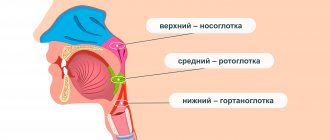Causes of pharyngitis in children
Pharyngitis occurs due to the ingress of various viruses and bacteria.
There are also a number of factors
that increase the likelihood
of developing the disease:
- hypothermia;
- decreased immunity;
- throat irritation from smoke, dust and chemicals;
- lack of vitamins and microelements;
- diseases of the stomach and intestines;
- disruption of the endocrine system;
- allergic reactions.
Acute pharyngitis can also be a manifestation of inflammatory pathology of the upper respiratory tract, intestinal and general infections, etc. Viruses have little effect on the development of the disease. Usually this is a herpes and influenza virus, enterovirus, adenovirus. Among the bacterial pathogens are Haemophilus influenzae, moraxella, diplococci, streptococci of groups C, A, G, etc.
Pharyngitis can develop against the background of a fungal infection. In general, pharyngitis of viral origin accounts for 70% of cases, bacterial and other – 30%. Pharyngitis can be accompanied by measles, ARVI, scarlet fever, etc. In some cases, the causes may be foreign bodies in the pharynx or burns in this area. The chronic form of the disease is usually associated with other diseases of the ENT organs of an inflammatory nature - adenoiditis, rhinitis, stomatitis, sinusitis, tonsillitis, etc.
Risk factors
Risk factors contributing to the development of pharyngitis include:
- the child eating food that is too cold (for example, ice cream);
- improper breathing (through the mouth), especially in winter;
- low level of immunity;
- lack of vitamins in the body;
- diseases of the gastrointestinal tract and endocrine system.
Allergic reactions can also provoke the occurrence of pharyngitis.
Free consultation on training issues
Our consultants are always ready to tell you about all the details!
Types of disease
According to the nature of the course, the disease is divided into:
- acute – lasts up to 1 month;
- protracted – lasts more than six months with frequent exacerbations;
- chronic - can occur in several forms - atrophic, catarrhal, hypertrophic.
according to the condition of the mucous membrane :
- catarrhal – characterized by swelling and redness of the mucous membranes;
- hypertrophic - with it the mucous membrane thickens because the epithelium grows;
- subatrophic - the mucous membrane becomes thinner and atrophies.
Classification
Based on the course, acute, subacute and chronic forms of pharyngitis are distinguished. There is also a classification based on the condition of the pharyngeal mucosa. With catarrhal pharyngitis, the pharynx looks swollen, hyperemic, with the mucous membrane gradually acquiring a characteristic gray-pink hue. With the hypertrophic form of pharyngitis, the mucous membranes of the larynx and pharynx become thicker, with hypertrophic growth of ridges on the side of the pharynx. The palatine arches also thicken, and granulosa and nodular formations are observed at the back of the pharynx.
The subatrophic type of pharyngitis leads to focal or diffuse thinning of tissue. In this case, the mucous membranes look pale, atrophied, with thinned blood vessels.
Symptoms and signs of pharyngitis in a child
The main signs of pharyngitis in children are:
- moderate pain;
- sore throat.
Hoarseness of voice and dry cough may also be observed. And with the reflux nature of the disease, there is a feeling of bitterness in the mouth.
In the acute form, the signs are as follows:
- dry throat, rawness, burning, soreness when swallowing;
- hoarseness of voice;
- shallow cough;
- high temperature if the disease develops against the background of a virus;
- headache;
- signs of general intoxication;
- enlargement of regional lymph nodes. Source: T.V. Kulichenko, A.M. Kabaloeva, Yu.S. Lashkova, M.A. Lazareva Diagnosis of acute pharyngitis in children // Pediatric pharmacology, 2014, v. 11, no. 4, pp. 59-66
In infants, the disease is more severe:
- sleep disturbance;
- fever;
- salivation;
- decreased appetite;
- swallowing disorder;
- conjunctivitis;
- runny nose;
- rashes on the body;
- discomfort and pain in the upper abdomen.
The chronic hyperplastic form is characterized by thickening of the mucous and submucosal layer, lymphoid tissues, dryness and sore throat, urge to vomit, painful swallowing, which radiates to the ear. Sometimes hearing loss develops because thickened tissue blocks the openings of the auditory tubes.
Usually, with pharyngitis, the temperature rises slightly. Temperatures above 38-39 degrees can only be observed if the tonsils are involved in the process.
If your child has a high fever, you should immediately consult your doctor. Experts do not recommend treating tonsillitis in a child without supervision from a pediatrician, since if treated incorrectly, the disease can lead to complications.
If pharyngitis does not go away for a long time, then it is necessary to look for the true cause of the disease.
Causes
Primary pharyngitis is associated with exposure to the pharyngeal mucosa of infectious agents. The disease can be provoked by intestinal and general infections, inflammation of the upper respiratory tract. In some cases, the cause is burns of the throat mucosa, foreign objects in the throat, or damage to the throat during surgery. The most common causative agents of pharyngitis are the following pathogenic microorganisms:
- influenza viruses, herpes, parainfluenza, cytomegalovirus, enteroviruses, adenoviruses, rhinoviruses;
- bacteria such as staphylococci, meningococci, streptococci, Haemophilus influenzae and diphtheria bacillus, corynebacteria, moraxella, diplococci;
- fungi, intracellular agents (chlamydia, mycoplasma).
Pharyngitis of viral etiology is observed in 70% of cases, bacterial and other ones account for 30%. Its acute form is associated with pathologies such as infectious mononucleosis, measles, scarlet fever, and ARVI. The chronic type of pharyngitis is more often diagnosed in patients with the following inflammatory diseases of the oropharynx:
- adenoiditis;
- sinusitis;
- stomatitis;
- rhinitis;
- chronic tonsillitis;
- sore throat;
- caries.
Risk factors for the development of pharyngitis include local or general hypothermia. There is a high probability of inflammation of the pharyngeal mucosa as a result of exposure to spicy food, tobacco smoke, dusty or cold air. Patients who have the following are also at risk:
- weakening of local immunity;
- removal of the palatine tonsils, after which atrophic changes in the pharyngeal mucosa are observed;
- gastroesophageal reflux, which causes stomach contents to flow into the throat;
- posterior rhinitis, in which mucus flows down the throat when blowing the nose;
- difficulty breathing through the nose, causing unpurified cold air to be inhaled through the mouth;
- allergies due to histamine reaching the mucous membrane of the throat.
Types and forms
Bacteria and viruses enter the mucous membrane of the pharynx from other areas of inflammation. For this reason, pharyngobronchitis, pharyngolaryngitis, nasopharyngitis and pharyngotonsillitis in children are diagnosed more often than the isolated form of pharyngitis. Depending on the nature of the course, the disease can be of the following types:
- Spicy. Inflammation continues for 2 weeks. The symptoms of the disease are pronounced. Pain and sore throat and dry cough are more common. The cause may be infectious and inflammatory processes in the trachea or nasopharynx.
- Chronic. It lasts for more than six months with frequent exacerbations.
Taking into account the area of inflammation, the disease is divided into 2 more types: widespread - the entire back surface of the pharynx is affected, limited - inflammation is observed only on the lateral ridges. Depending on the location, chronic pharyngitis in children can be presented in the following forms:
- catarrhal (only the mucous membrane of the throat is affected);
- granulosa (inflammation is located deeper in the lymphoid follicles);
- atrophic (accompanied by drying out of inflamed tissues).
Symptoms
Pharyngitis in a child is accompanied by pain when swallowing, dryness, rawness and sore throat. Against this background, a shallow cough is observed, and hoarseness appears. When examining the throat, the following signs can be noted:
- redness of the wall of the pharynx, soft palate and velopharyngeal arches;
- a granular throat in a child with protruding, inflamed follicles;
- hyperemia and swelling of the uvula, lateral ridges of the pharynx.
The temperature of a child with pharyngitis can be normal or low-grade (37 degrees). It rises higher if the disease develops against the background of viral diseases. Then the little patient experiences fever, headache and swelling of the submandibular lymph nodes. The following symptoms indicate a chronic course of the disease:
- obsessive cough;
- sensation of a foreign body in the throat;
- loose mucous membrane of the throat.
Depending on the form and nature of the disease, very different, subjective symptoms may be observed. The main ones are the following:
- With a fungal form (pharyngomycosis). There are erosions and cracks in the corners of the mouth (jams), a cheesy coating on the back wall of the pharynx, and enlarged lymph nodes in the neck.
- In the atrophic form. Thinning, pallor and dryness of the mucous membrane of the throat are diagnosed. It contains hard-to-remove dried crusts.
- In chronic hyperplastic form. The child may complain of a dry and sore throat. Thick mucus accumulates on the pharyngeal mucosa, which can cause vomiting. Against this background, hyperplasia of the throat epithelium can be noted.
Acute pharyngitis
It has a clear clinical picture. The child complains that it hurts to swallow, itching, dryness and sore throat. The increase in temperature is insignificant - up to 37-38 degrees. If the illness occurs against the background of a cold, then all its characteristic symptoms will appear, including cough, runny nose, and conjunctivitis. With an “empty throat”, the pain in the throat intensifies - this is a characteristic symptom.
In children, hypertrophied inflammation of the pharyngeal mucosa is observed. Large and medium-sized granulations form on it, which cause pain. Characteristic symptoms of the acute form are the following:
- child's refusal to eat;
- irradiation of pain in the ear and lower jaw;
- pinpoint hemorrhages in the hard palate;
- pain and enlargement of regional nodes;
- drowsiness, apathy.
Chronic
A distinctive sign of the chronic form of the disease is a false cough, in which sputum is not produced. It is celebrated mainly at night. Mucus accumulates on the back wall of the throat, which the child constantly swallows reflexively. When examining the throat, you may notice its redness and graininess. Purulent plaque is observed only with a bacterial etiology of the disease. Other distinctive features are presented in the list:
- slight increase in temperature in the morning;
- dry throat, which causes you to constantly swallow;
- hoarseness of voice;
- feeling of stuffiness in the upper part of the throat;
- malaise.
Pharyngitis in infants
The disease is much more severe in infants. Since they cannot say what bothers them, the parents themselves have to identify the disease. In infants, general symptoms predominate, expressed by signs from the following list:
- poor sleep, anxiety;
- periodic coughing;
- tearfulness and moodiness;
- temperature 39 degrees;
- regurgitation after feeding;
- loss of appetite;
- salivation - salivation;
- dysphagia – a disorder of swallowing;
- severe fever;
- rash on the body;
- dyspepsia;
- runny nose.
Complications
Most complications of the disease occur due to improper treatment. The infection spreads throughout the body, primarily affecting the respiratory tract, although inflammation can also affect the membranes of the brain. The list of complications of pharyngitis includes the following serious diseases: Otitis, Tonsillitis, Sinusitis, Rhinitis, Conjunctivitis, Meningitis.
Treatment of pharyngitis in children
Treatment of this disease in childhood is often limited to local treatment. It consists of inhalation and rinsing. Young children who cannot rinse their mouths are recommended to drink plenty of fluids and drip irrigation of the mucous membranes with antiseptics. If the child already knows how to dissolve tablets, then he is prescribed lozenges with analgesic, antibacterial and softening effects.
To prevent pharyngitis from getting worse in children, it is necessary to take measures to treat the underlying disease: caries, tonsils, adenoids, intestinal dysbiosis, colds, rhinitis, sinusitis, etc. Taking into account the etiology of inflammation of the pharyngeal mucosa, systemic therapy with the following drugs is prescribed:
- antibiotics - for bacterial infections;
- antiviral – for viral infections;
- antimycotics – for fungal infections;
- antihistamines - for allergies.
Antibacterial agents can also be used topically, for example, such as Bioparox, Grammidin or Orasept. Regardless of the chosen regimen, treatment should be aimed at achieving the following goals:
- normalization of temperature - it is recommended to take antipyretic drugs, for example, children's Paracetamol or Cefecol;
- reduction of pain and discomfort in the throat - inhalations, rinsing, warm, generous drinks are indicated;
- ensuring complete rest - bed rest is prescribed;
- elimination of nasal congestion - it is necessary to instill vasoconstrictor drops into the nostrils;
- strengthening the immune system - for this purpose, Grippferon or Derinat is instilled into the nose.
Treatment of pharyngitis in children at home
If the child has no complications or high fever, the doctor may allow treatment at home. An important criterion for recovery in this case is compliance with bed rest during the acute period - until the temperature drops to normal values. Parents must follow the following rules:
- give the baby only warm food;
- exclude spicy foods that irritate the throat mucosa;
- regularly ventilate the patient’s room;
- carry out wet cleaning and humidify the air daily;
- limit the patient's vocal load.
You can give drink not only warm water, but also milk with honey or soda. If the temperature has subsided, then hot foot baths are allowed. To gargle, use decoctions of chamomile, oak bark, and calendula.
To eliminate unpleasant symptoms in the throat, inhalations are indicated. It is better to carry them out using a nebulizer. The recommended frequency of the procedure is 1-4 times per day. Borjomi mineral water, Furacilin solution or saline solution are suitable for inhalation. The latter can be diluted with tincture of calendula or propolis in a ratio of 20:1.
Prevention
An important condition for the prevention of this disease in childhood is routine vaccination. Maintaining proper nutrition and taking vitamins will help prevent any inflammation of the respiratory tract. The child needs to be provided with regular daily exposure to fresh air. The list of preventive measures includes the following:
- hardening;
- limiting contact with sick people;
- ventilation of the home and regular wet cleaning;
- promptly treat colds, rhinitis, sinusitis, adenoiditis;
- Avoid child contact with tobacco smoke and dust.
Bibliography:
Diseases of the ear, nose and throat Luchikhin L.A. /2010
Pediatric otorhinolaryngology. Volume 1, Chistyakova V.R./2005
All about ENT diseases. Pechkareva A.V./2013
Otorhinolaryngologist L.V. Ledova
Diagnostic methods
The diagnosis and treatment of tonsillitis in a child is carried out by a pediatrician or otolaryngologist. This disease must be distinguished from other infectious pathologies, including diphtheria and catarrhal tonsillitis. Therefore, you should also contact a pediatric allergist-immunologist and infectious disease specialist. After the examination, the doctor will prescribe laboratory tests (smear for microflora and sensitivity to viruses, bacteria, general blood test. Source: https://www.ncbi.nlm.nih.gov/pmc/articles/PMC5807738/ Thea Brennan-Krohn, Al Ozonoff and Thomas J. Sandora Adherence to guidelines for testing and treatment of children with pharyngitis: a retrospective study // BMC Pediatr. 2018; 18: 43
For recurrent forms of the disease, endoscopy of the nose and nasopharynx, consultation with an allergist, examination by a gastroenterologist, and endoscopy of the larynx will be required. All this is necessary to identify the true nature of the pathology.
Complications
Pharyngitis is a safe disease that responds well to treatment, provided it is properly managed. If a chronic form develops, in which the symptoms become permanent, it poses a great danger and is difficult to treat. She often quotes:
- to chronic bronchitis;
- laryngitis;
- tracheitis.
Free consultation on training issues
Our consultants are always ready to tell you about all the details!
In severe cases, the development of peritonsillar abscess or acute rheumatism of the joints is possible (if pharyngitis was caused by group A beta-hemolytic streptococcus).
Treatment of pharyngitis in children
How to treat this pharyngitis depends on the root cause of this disease in children . It is also necessary to eliminate unpleasant symptoms and generally strengthen the body.
Treatment of pharyngitis in a child includes:
- gargling with herbal decoctions or antiseptics (for children over three years old);
- antiseptics - for rinsing and local - lozenges and lozenges;
- anti-inflammatory drugs;
- antibacterial therapy;
- a gentle diet (excluding foods that irritate the mucous membrane);
- inhalation with a nebulizer to moisturize the mucous membrane with solutions based on mineral waters. Source: T.A. Polunina, E.V. Vishneva Pharyngitis in children // Pediatric pharmacology, 2011, vol. 8, no. 5, pp. 106-108
Also for the treatment of pharyngitis, antihistamines are indicated to relieve swelling, humidify the air in the room to facilitate breathing, inhalation, and vocal rest. It is advisable that the child’s diet include food that does not irritate the throat - pureed, liquid, soft, non-spicy.
Complications of pharyngitis due to improper self-medication and lack of treatment
The spread of infection leads to complications of an inflammatory nature: sinusitis, otitis, bronchitis, etc. But the long-term consequences of streptococcal pharyngitis pose a much greater danger. This microorganism provokes immune aggression against the body's own tissues, which causes endocarditis - inflammation of the inner lining of the heart, glomerulonephritis - pathology of the kidneys and joints.
Long-term consequences can lead to disability and even death of the child.
Clinical recommendations for prevention
It is necessary to strengthen the child’s immunity - carry out regular hardening exercises, adjust the diet so that healthy and vitamin-rich food predominates in it, and take walks in the fresh air more often. In addition, it is necessary to promptly and completely cure infections of the respiratory tract and oral cavity, not to cause caries, otitis media, sinusitis, and stomatitis. It is important to prevent and promptly treat gastrointestinal diseases. To prevent the disease from becoming chronic, you must consult a doctor in a timely manner.
The children's medical department has all the capabilities to treat various diseases, including pharyngitis. Doctors at the medical center will diagnose and prescribe treatment as soon as possible.
Sources:
- T.V. Kulichenko, A.M. Kabaloeva, Yu.S. Lashkova, M.A. Lazarev. Diagnosis of acute pharyngitis in children // Pediatric pharmacology, 2014, vol. 11, no. 4, pp. 59-66.
- https://www.ncbi.nlm.nih.gov/pmc/articles/PMC5807738/ Thea Brennan-Krohn, Al Ozonoff and Thomas J. Sandora. Adherence to guidelines for testing and treatment of children with pharyngitis: a retrospective study // BMC Pediatr. 2018; 18:43.
- T.A. Polunina, E.V. Vishneva. Pharyngitis in children // Pediatric pharmacology, 2011, vol. 8, no. 5, pp. 106-108.
Zaichenko Vladislav Sergeevich Clinic
Author of the article
Zaichenko Vladislav Sergeevich
Specialty: otolaryngologist
Experience: 18 years
The information in this article is provided for reference purposes and does not replace advice from a qualified professional. Don't self-medicate! At the first signs of illness, you should consult a doctor.
Prevention of pharyngitis
Everyone knows that it is much easier to prevent a disease than to subsequently treat it. In order to avoid the development of pharyngitis, the following rules must be followed:
- Try not to overcool the body.
- Limit the consumption of cold and hot foods, as well as the intake of cold and hot drinks.
- Stop smoking in the presence of your child.
- Regularly carry out wet cleaning of rooms.
- Make sure that your breathing is correct (the child should breathe through his nose - this is how the air warms up and is neutralized).
- Visit a doctor promptly if there is any suspicion of pathology of the throat and nose.
By following these rules, you can reduce the risk of developing ENT diseases in your child to a minimum.
“SM-Doctor” is a specialized clinic for children and adolescents, staffed by qualified specialists who regularly improve their professionalism. We examine and treat children in accordance with world-class medical guidelines. “SM-Doctor” provides only reasonable diagnostics and proven effective treatment. Contact professionals so that your child has good health and strong immunity!
Differences from bacterial
Visually determining the cause of inflammation is almost impossible. Only at an advanced stage of the disease can some signs of bacterial or viral inflammation be visible. At first, visually, viral pharyngitis has the same symptoms as bacterial pharyngitis.
At the same time, the presence of viral damage to the body can be distinguished by the degree of temperature increase. With bacterial inflammation of the pharynx, the temperature does not exceed 38o, while with a viral disease it rises much higher, sometimes to critical values. Also, when the disease has already developed to a significant extent, the fact that it is of a viral nature is indicated by the absence of plaque on the inflamed tissues and purulent discharge. It is not uncommon for viral and secondary bacterial lesions to be combined. This is established using tests, and then complex treatment is required, in which drugs against two types of pathogens will be used.
For an accurate diagnosis, a patient is examined with a blood test and a pharyngeal swab. Only the results of these diagnostic measures make it possible to determine what caused the inflammation and what therapy - antibacterial or antiviral - is required. Viral pharyngitis has the same symptoms and treatment in adults as in children.
During pregnancy
In pregnant women, viral infection of the pharyngeal mucosa is a fairly common phenomenon due to reduced immunity in the period up to childbirth. This weakening of the defense is necessary so that the body does not reject the fetus, which is a foreign object for it.
The main danger with the viral form of pharyngitis is observed in the first trimester of pregnancy and in the last month, when severe intoxication of the body can cause miscarriage or premature birth. Therapy for the disease is somewhat complicated by the fact that most medications are prohibited for use by pregnant women. Self-medication when carrying a child is strictly prohibited, as it can easily only seriously aggravate the condition and cause irreparable harm to the unborn child.
For treatment, topical medications such as lozenges, lozenges and sprays are most often used. They penetrate into the systemic bloodstream in minimal quantities and cannot harm the child. However, not all of them can be used, but only a small part. The drug is prescribed by the doctor, taking into account the individual characteristics of the woman and the duration of pregnancy.









